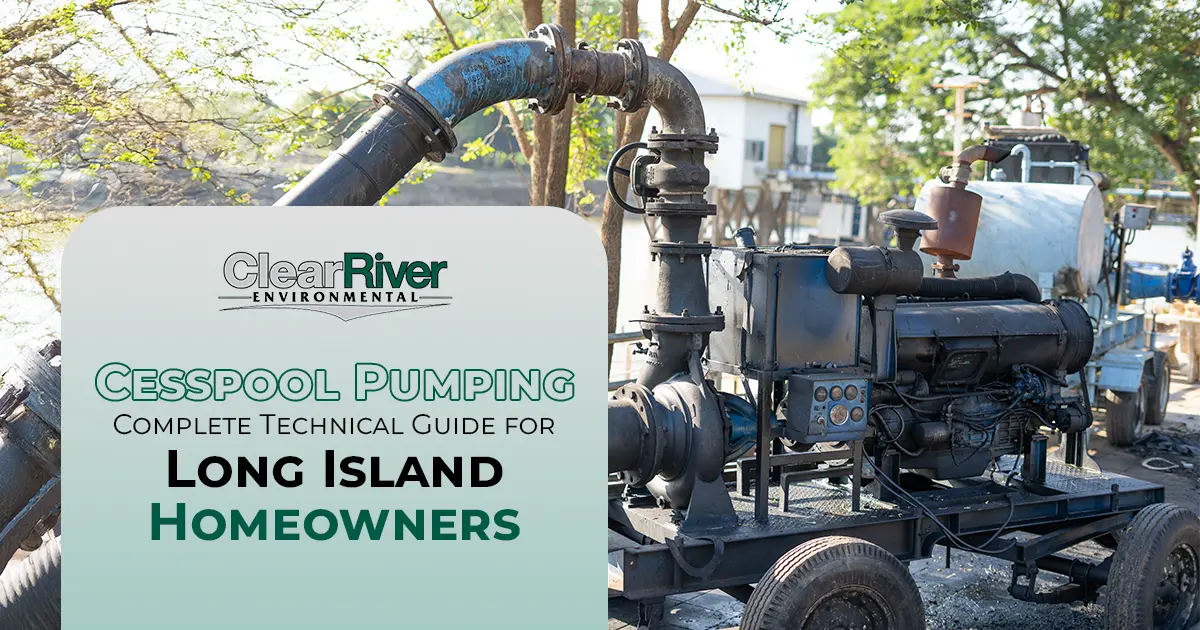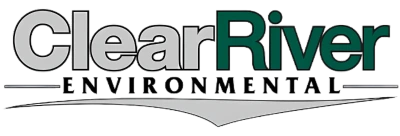Cesspool Pumping & Complete Technical Guide for Long Island Homeowners
- David Warren
- August 4, 2025

Are you a Long Island homeowner or engineer working with onsite wastewater? The regulations for cesspool pumping, cesspool care, and installation are stricter than ever in New York. This guide covers everything you need: how cesspools work, pumping schedules, cesspool installation guide, and Clear River Environmental’s best practices for maintenance.
In This Article
What Is Cesspool?
A cesspool is a concrete or brick-lined pit that collects wastewater from your home’s plumbing. It acts as a basic onsite waste management system, common in Long Island and across New York State, but is now outdated compared to modern septic systems.
What Is a Cesspool System on Long Island?
A cesspool system consists of a single chamber—typically perforated—where solids settle and liquids leach out to the surrounding soil. Unlike multi-chamber septic systems, it offers minimal treatment and is vulnerable to failure if not maintained.
How Does a Cesspool Work?
Cesspools handle wastewater by gravity. Effluent from toilets, sinks, and laundry flows into the chamber. Solids remain and slowly decompose at the bottom, while liquids escape through side walls into the drainfield. Over time, buildup reduces capacity and increases risk of overflow—making regular cesspool pumping crucial.
How Do Cesspools Work vs Septic Systems?
- Cesspools: No baffles, settling tanks, or effluent filters. High risk of clogging and nitrogen pollution.
- Septic systems: Settle solids first, only filtered liquids reach the leach field—far safer for NY groundwater.
- Local law: Replacement with an advanced system is required if your cesspool fails.
Do Cesspools Need to Be Pumped on Long Island?
Yes—cesspool pumping is mandatory for all Long Island homes with existing systems.
Recommended pumping interval: Every 2–3 years, or more often if you have large household usage.
To schedule certified pumping, contact Clear River Environmental.
Cesspool Pumping: Professional Schedule for Nassau & Suffolk Counties
- Routine cesspool pumping: Prevents backups, odors, and system collapse.
- Signs you need pumping: Slow drains, wet areas near tank, odors indoors or outside.
- Legal Note: Missed pump-outs or failed reports can mean fines of $250–$2,000 in New York.
For certified pumping service, book with Clear River Environmental—local experts for Nassau and Suffolk.
Cesspool Pump: What Homeowners & Engineers Should Know
If your system includes a cesspool pump:
- Function: Moves effluent when gravity flow isn’t possible (low-lying sites).
- Maintenance: Inspect pump chamber, floats, and alarm system annually.
- Troubleshooting: Loud noises, constant running, or fluid not moving means you need immediate service.
Contact Clear River Environmental for pump troubleshooting and replacement.
Cesspool Drainage: Common Problems and Solutions
Blocked drainage can cause surface flooding and rapid system failure.
- Causes: Soap/grease scum, tree root intrusion, soil compaction, collapsed walls.
- Fix: Professional jetting, mechanical rodding, or full replacement—never DIY dangerous repairs.
- Emergency? Clear River Environmental offers 24/7 service across Long Island.
Cesspool Care: Long Island’s Complete Maintenance Checklist
Annual Checklist for Homeowners
- Professional inspection (licensed technician): Check structure, inflow pipe, and visible leaks.
- Pump cesspool: Every 2–3 years, or at signs of trouble.
- Surface check: Remove roots, check for wet/soft soil and odors, clear vents.
- Inflow protection: Install lint and hair screens on washing machine/drain lines.
- Water conservation: Repair leaks, use low-flow toilets and showerheads.
- Chemical caution: Never flush bleach, pesticides, grease, non-biodegradable wipes, or feminine hygiene products.
- Keep records: Document inspections, repairs, and pump-outs—required by New York law.
Engineering Checklist (For Installers/Maintenance Pros)
- Verify cesspool compliance to NY/Long Island code.
- Inspect for infiltration, tank settlement, baffle condition (if present).
- Confirm proper drainage slope and location, away from wells and foundation (per code).
- Advise on upgrades to IA/OWTS solutions if recurring problems found.
- Submit mandatory service/inspection reports to county database.
Stay compliant and safe—schedule all maintenance with licensed Clear River Environmental technicians.
Cesspool Installation Guide for Long Island & NY Engineers
- Step-by-Step Installation (Summary)
- Site Assessment:
- Soil percolation test
- Distance to wells/buildings (min. 100 ft)
- Check groundwater depth
- Permitting:
- Secure all Nassau or Suffolk permits
- Submit system design to county health department
- Excavation and Placement:
- Excavate to code-mandated depth
- Bed of sand or gravel for base stability
- Lower precast/approved cesspool unit carefully
- Piping and Connections:
- Connect inlet pipe with minimum slope (1/4” per foot)
- Install effluent filter on main outflow
- Ensure watertight seals at all joints
- Backfilling and Drainage Testing:
- Backfill around unit as per specs
- Perform water-tightness/drainage tests
- Final inspection by county official
- Surface Restoration:
- Restore grade, mark access point, post signage if needed
- Site Assessment:
Legal & Best Practices
- Direct cesspool replacement is usually not allowed—upgrade to septic or IA system if required by county code.
- Engineer tip: Always opt for state-approved advanced treatment systems for new projects.
For code-compliant new installs or retrofits, trust Clear River Environmental—local NY experts with full engineering support.
Why Long Island Homeowners Need Licensed Cesspool Service
- Unlicensed work risks steep fines and failed inspections.
- Only licensed pros like Clear River Environmental can certify, inspect, pump, and report under current Nassau/Suffolk and NY State rules.
- Local support means 24/7 help, fast repairs, and the latest in green system upgrades.
Conclusion: Stay Safe—Partner With Long Island’s Clear River Environmental
Smart cesspool care and proper installation protect your family and community in New York. Regular cesspool pumping, annual inspections, and new code-compliant installations are simple with the right partner.
For full service, from maintenance to engineering and cesspool installation:
Contact Clear River Environmental at 631-467-5447 for certified cesspool care across Long Island, Nassau, and Suffolk Counties.
Get in touch with Us

David Warren
David Warren, Vice President and one of the founding visionaries of Clear River Environmental, brings
deep expertise in environmental stewardship, residential services, and operational leadership. Since cofounding the company, he has been instrumental in guiding Clear River’s evolution from a local cesspool service to Long Island’s leading provider of plumbing, septic, and environmental solutions, completing over 25,000 installations to date.
